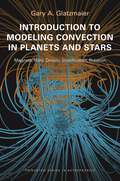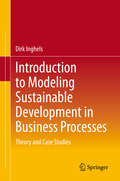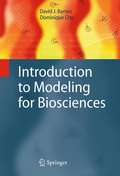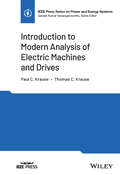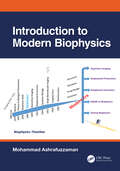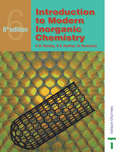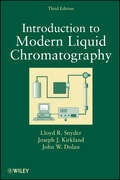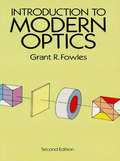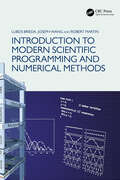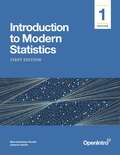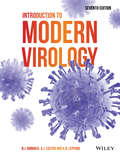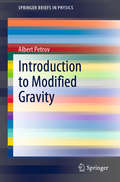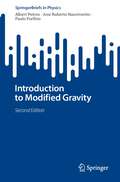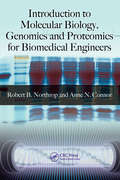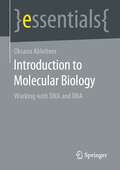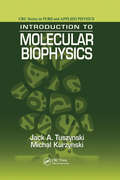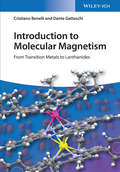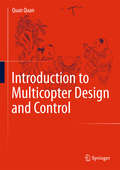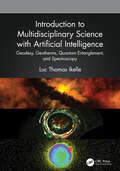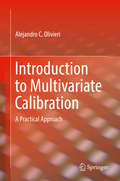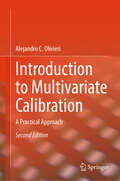- Table View
- List View
Introduction to Modeling Cognitive Processes
by Tom VergutsAn introduction to computational modeling for cognitive neuroscientists, covering both foundational work and recent developments. Cognitive neuroscientists need sophisticated conceptual tools to make sense of their field&’s proliferation of novel theories, methods, and data. Computational modeling is such a tool, enabling researchers to turn theories into precise formulations. This book offers a mathematically gentle and theoretically unified introduction to modeling cognitive processes. Theoretical exercises of varying degrees of difficulty throughout help readers develop their modeling skills. After a general introduction to cognitive modeling and optimization, the book covers models of decision making; supervised learning algorithms, including Hebbian learning, delta rule, and backpropagation; the statistical model analysis methods of model parameter estimation and model evaluation; the three recent cognitive modeling approaches of reinforcement learning, unsupervised learning, and Bayesian models; and models of social interaction. All mathematical concepts are introduced gradually, with no background in advanced topics required. Hints and solutions for exercises and a glossary follow the main text. All code in the book is Python, with the Spyder editor in the Anaconda environment. A GitHub repository with Python files enables readers to access the computer code used and start programming themselves. The book is suitable as an introduction to modeling cognitive processes for students across a range of disciplines and as a reference for researchers interested in a broad overview.
Introduction to Modeling Convection in Planets and Stars: Magnetic Field, Density Stratification, Rotation (Princeton Series in Astrophysics #24)
by Gary A. GlatzmaierThis book provides readers with the skills they need to write computer codes that simulate convection, internal gravity waves, and magnetic field generation in the interiors and atmospheres of rotating planets and stars. Using a teaching method perfected in the classroom, Gary Glatzmaier begins by offering a step-by-step guide on how to design codes for simulating nonlinear time-dependent thermal convection in a two-dimensional box using Fourier expansions in the horizontal direction and finite differences in the vertical direction. He then describes how to implement more efficient and accurate numerical methods and more realistic geometries in two and three dimensions. In the third part of the book, Glatzmaier demonstrates how to incorporate more sophisticated physics, including the effects of magnetic field, density stratification, and rotation. Featuring numerous exercises throughout, this is an ideal textbook for students and an essential resource for researchers. Describes how to create codes that simulate the internal dynamics of planets and stars Builds on basic concepts and simple methods Shows how to improve the efficiency and accuracy of the numerical methods Describes more relevant geometries and boundary conditions Demonstrates how to incorporate more sophisticated physics
Introduction to Modeling Sustainable Development in Business Processes: Theory and Case Studies
by Dirk InghelsSustainable development and corporate social responsibility drive countries, regions, and businesses to take environmental and social concerns into account when realizing economic objectives. A growing awareness of the connectedness between industrial, societal, and environmental systems might shift the way businesses will be operated. This book aims to help students and business practitioners use quantitative modeling in their pursuit to make business processes sustainable. Two approaches are introduced: linear optimization and system dynamics. Moreover, the quantification of the three different sustainability objectives is also addressed. Next to introducing the theoretical background, many real-life examples are discussed to demonstrate how the modelling techniques can be applied.
Introduction to Modeling and Numerical Methods for Biomedical and Chemical Engineers
by Edward GatzkeThis textbook introduces the concepts and tools that biomedical and chemical engineering students need to know in order to translate engineering problems into a numerical representation using scientific fundamentals. Modeling concepts focus on problems that are directly related to biomedical and chemical engineering. A variety of computational tools are presented, including MATLAB, Excel, Mathcad, and COMSOL, and a brief introduction to each tool is accompanied by multiple computer lab experiences. The numerical methods covered are basic linear algebra and basic statistics, and traditional methods like Newton’s method, Euler Integration, and trapezoidal integration. The book presents the reader with numerous examples and worked problems, and practice problems are included at the end of each chapter.
Introduction to Modeling for Biosciences
by Dominique Chu David J. BarnesMathematical modeling can be a useful tool for researchers in the biological scientists. Yet in biological modeling there is no one modeling technique that is suitable for all problems. Instead, different problems call for different approaches. Furthermore, it can be helpful to analyze the same system using a variety of approaches, to be able to exploit the advantages and drawbacks of each. In practice, it is often unclear which modeling approaches will be most suitable for a particular biological question, a problem which requires researchers to know a reasonable amount about a number of techniques, rather than become experts on a single one. "Introduction to Modeling for Biosciences" addresses this issue by presenting a broad overview of the most important techniques used to model biological systems. In addition to providing an introduction into the use of a wide range of software tools and modeling environments, this helpful text/reference describes the constraints and difficulties that each modeling technique presents in practice, enabling the researcher to quickly determine which software package would be most useful for their particular problem. Topics and features: introduces a basic array of techniques to formulate models of biological systems, and to solve them; intersperses the text with exercises throughout the book; includes practical introductions to the Maxima computer algebra system, the PRISM model checker, and the Repast Simphony agent modeling environment; discusses agent-based models, stochastic modeling techniques, differential equations and Gillespie's stochastic simulation algorithm; contains appendices on Repast batch running, rules of differentiation and integration, Maxima and PRISM notation, and some additional mathematical concepts; supplies source code for many of the example models discussed, at the associated website http://www.cs.kent.ac.uk/imb/. This unique and practical guide leads the novice modeler through realistic and concrete modeling projects, highlighting and commenting on the process of abstracting the real system into a model. Students and active researchers in the biosciences will also benefit from the discussions of the high-quality, tried-and-tested modeling tools described in the book. Dr. David J. Barnes is a lecturer in computer science at the University of Kent, UK, with a strong background in the teaching of programming. Dr. Dominique Chu is a lecturer in computer science at the University of Kent, UK. He is an internationally recognized expert in agent-based modeling, and has also in-depth research experience in stochastic and differential equation based modeling.
Introduction to Modern Analysis of Electric Machines and Drives (IEEE Press Series on Power and Energy Systems)
by Paul C. Krause Thomas C. KrauseIntroduction to Modern Analysis of Electric Machines and Drives Comprehensive resource introducing magnetic circuits and rotating electric machinery, including models and discussions of control techniques Introduction to Modern Analysis of Electric Machines and Drives is written for the junior or senior student in Electrical Engineering and covers the essential topic of machine analysis for those interested in power systems or drives engineering. The analysis contained in the text is based on Tesla’s rotating magnetic field and reference frame theory, which comes from Tesla’s work and is presented for the first time in an easy to understand format for the typical student. Since the stators of synchronous and induction machines are the same for analysis purposes, they are analyzed just once. Only the rotors are different and therefore analyzed separately. This approach makes it possible to cover the analysis efficiently and concisely without repeating derivations. In fact, the synchronous generator equations are obtained from the equivalent circuit, which is obtained from work in other chapters without any derivation of equations, which differentiates Introduction to Modern Analysis of Electric Machines and Drives from all other textbooks in this area. Topics explored by the two highly qualified authors in Introduction to Modern Analysis of Electric Machines and Drives include: Common analysis tools, covering steady-state phasor calculations, stationary magnetically linear systems, winding configurations, and two- and three-phase stators Analysis of the symmetrical stator, covering the change of variables in two- and three-phase transformations and more Symmetrical induction machines, covering symmetrical two-pole two-phase rotor windings, electromagnetic force and torque, and p-pole machines Direct current machines and drives, covering commutation, voltage and torque equations, permanent-magnet DC machines, and DC drives Introduction to Modern Analysis of Electric Machines and Drives is appropriate as either a first or second course in the power and drives area. Once the reader has covered the material in this book, they will have a sufficient background to start advanced study in the power systems or drives areas.
Introduction to Modern Biophysics
by Mohammad AshrafuzzamanThis textbook provides an introduction to the fundamental and applied aspects of biophysics for advanced undergraduate and graduate students of physics, chemistry, and biology. The application of physics principles and techniques in exploring biological systems has long been a tradition in scientific research. Biological systems hold naturally inbuilt physical principles and processes which are popularly explored. Systematic discoveries help us understand the structures and functions of individual biomolecules, biomolecular systems, cells, organelles, tissues, and even the physiological systems of animals and plants. Utilizing a physics- based scientific understanding of biological systems to explore disease is at the forefront of applied scientific research. This textbook covers key breakthroughs in biophysics whilst looking ahead to future horizons and directions of research. It contains models based on both classical and quantum mechanical treatments of biological systems. It explores diseases related to physical alterations in biomolecular structures and organizations alongside drug discovery strategies. It also discusses the cutting- edge applications of nanotechnologies in manipulating nanoprocesses in biological systems. Key Features: • Presents an accessible introduction to how physics principles and techniques can be used to understand biological and biochemical systems. • Addresses natural processes, mutations, and their purposeful manipulation. • Lays the groundwork for vitally important natural scientific, technological, and medical advances. Mohammad Ashrafuzzaman, a biophysicist and condensed matter scientist, is passionate about investigating biological and biochemical processes utilizing physics principles and techniques. He is a professor of biophysics at King Saud University’s Biochemistry Department in the College of Science, Riyadh, Saudi Arabia; the co- founder of MDT Canada Inc., and the founder of Child Life Development Institute, Edmonton, Canada. He has authored Biophysics and Nanotechnology of Ion Channels, Nanoscale Biophysics of the Cell, and Membrane Biophysics. He has also published about 50 peer- reviewed articles and several patents, edited two books, and has been serving on the editorial boards of Elsevier and Bentham Science journals. Dr. Ashrafuzzaman has held research and academic ranks at Bangladesh University of Engineering & Technology, University of Neuchatel (Switzerland), Helsinki University of Technology (Finland), Weill Medical College of Cornell University (USA), and University of Alberta (Canada). During 2013– 2018 he also served as a Visiting Professor at the Departments of Oncology, and Medical Microbiology and Immunology, of the University of Alberta. Dr. Ashrafuzzaman earned his highest academic degree, Doctor of Science (D.Sc.) in condensed matter physics from the University of Neuchatel, Switzerland in 2004.
Introduction to Modern Inorganic Chemistry, 6th edition
by R. A. Mackay W. HendersonThis popular and comprehensive textbook provides all the basic information on inorganic chemistry that undergraduates need to know. For this sixth edition, the contents have undergone a complete revision to reflect progress in areas of research, new and modified techniques and their applications, and use of software packages.Introduction to Modern Inorganic Chemistry begins by explaining the electronic structure and properties of atoms, then describes the principles of bonding in diatomic and polyatomic covalent molecules, the solid state, and solution chemistry. Further on in the book, the general properties of the periodic table are studied along with specific elements and groups such as hydrogen, the 's' elements, the lanthanides, the actinides, the transition metals, and the "p" block. Simple and advanced examples are mixed throughout to increase the depth of students' understanding.This edition has a completely new layout including revised artwork, case study boxes, technical notes, and examples. All of the problems have been revised and extended and include notes to assist with approaches and solutions. It is an excellent tool to help students see how inorganic chemistry applies to medicine, the environment, and biological topics.
Introduction to Modern Liquid Chromatography
by Lloyd R. Snyder Joseph J. Kirkland John W. DolanThe latest edition of the authoritative reference to HPLCHigh-performance liquid chromatography (HPLC) is today the leading technique for chemical analysis and related applications, with an ability to separate, analyze, and/or purify virtually any sample. Snyder and Kirkland's Introduction to Modern Liquid Chromatography has long represented the premier reference to HPLC. This Third Edition, with John Dolan as added coauthor, addresses important improvements in columns and equipment, as well as major advances in our understanding of HPLC separation, our ability to solve problems that were troublesome in the past, and the application of HPLC for new kinds of samples.This carefully considered Third Edition maintains the strengths of the previous edition while significantly modifying its organization in light of recent research and experience. The text begins by introducing the reader to HPLC, its use in relation to other modern separation techniques, and its history, then leads into such specific topics as:The basis of HPLC separation and the general effects of different experimental conditionsEquipment and detectionThe column--the "heart" of the HPLC systemReversed-phase separation, normal-phase chromatography, gradient elution, two-dimensional separation, and other techniquesComputer simulation, qualitative and quantitative analysis, and method validation and quality controlThe separation of large molecules, including both biological and synthetic polymersChiral separations, preparative separations, and sample preparationSystematic development of HPLC separations--new to this editionTroubleshooting tricks, techniques, and case studies for both equipment and chromatogramsDesigned to fulfill the needs of the full range of HPLC users, from novices to experts, Introduction to Modern Liquid Chromatography, Third Edition offers the most up-to-date, comprehensive, and accessible survey of HPLC methods and applications available.
Introduction to Modern Magnetohydrodynamics
by Sébastien GaltierNinety-nine percent of ordinary matter in the Universe is in the form of ionized fluids, or plasmas. The study of the magnetic properties of such electrically conducting fluids, magnetohydrodynamics (MHD), has become a central theory in astrophysics, as well as in areas such as engineering and geophysics. This textbook offers a comprehensive introduction to MHD and its recent applications, in nature and in laboratory plasmas; from the machinery of the Sun and galaxies, to the cooling of nuclear reactors and the geodynamo. It exposes advanced undergraduate and graduate students to both classical and modern concepts, making them aware of current research and the ever-widening scope of MHD. Rigorous derivations within the text, supplemented by over 100 illustrations and followed by exercises and worked solutions at the end of each chapter, provide an engaging and practical introduction to the subject and an accessible route into this wide-ranging field. Addresses a broad range of applications across the subject areas of astrophysics, geophysics and engineering. Includes cutting-edge advances on turbulence and the Hall effect in the theory of MHD, providing an up-to-date scope of the field. Rigorous derivations provide a firm mathematical grounding in the subject, with exercises and worked solutions for the reader to engage with Over 100 illustrations give additional explanation and context to this introductory text.
Introduction to Modern Optics (Dover Books on Physics)
by Grant R. FowlesThis incisive text provides a basic undergraduate-level course in modern optics for students in physics, technology and engineering. The first half of the book deals with classical physical optics; the second principally with the quantum nature of light. Chapters 1 and 2 treat the propagation of light waves, including the concepts of phase and group velocities, and the vectorial nature of light. Chapter 3 applies the concepts of partial coherence and coherence length to the study of interference, and Chapter 4 takes up multiple-beam interference and includes Fabry-Perot interferometry and multilayer-film theory. Diffraction and holography are the subjects of Chapter 5, and the propagation of light in material media (including crystal and nonlinear optics) are central to Chapter 6. Chapters 7 and 8 introduce the quantum theory of light and elementary optical spectra, and Chapter 9 explores the theory of light amplification and lasers. Chapter 10 briefly outlines ray optics in order to introduce students to the matrix method for treating optical systems and to apply the ray matrix to the study of laser resonators.Many applications of the laser to the study of optics are integrated throughout the text. The author assumes students have had an intermediate course in electricity and magnetism and some advanced mathematics beyond calculus. For classroom use, a list of problems is included at the end of each chapter, with selected answers at the end of the book.
Introduction to Modern Scientific Programming and Numerical Methods
by Joseph Wang Lubos BriedaThe ability to use computers to solve mathematical relationships is a fundamental skill for anyone planning for a career in science or engineering. For this reason, numerical analysis is part of the core curriculum for just about every undergraduate physics and engineering department. But for most physics and engineering students, practical programming is a self-taught process.This book introduces the reader not only to the mathematical foundation but also to the programming paradigms encountered in modern hybrid software-hardware scientific computing. After completing the text, the reader will be well-versed in the use of different numerical techniques, programming languages, and hardware architectures, and will be able to select the appropriate software and hardware tool for their analysis.It can serve as a textbook for undergraduate courses on numerical analysis and scientific computing courses within engineering and physical sciences departments. It will also be a valuable guidebook for researchers with experimental backgrounds interested in working with numerical simulations, or to any new personnel working in scientific computing or data analysis.Key Features: Includes examples of solving numerical problems in multiple programming languages, including MATLAB, Python, Fortran, C++, Arduino, Javascript, and Verilog Provides an introduction to modern high-performance computing technologies including multithreading, distributed computing, GPUs, microcontrollers, FPGAs, and web "cloud computing" Contains an overview of numerical techniques not found in other introductory texts including particle methods, finite volume and finite element methods, Vlasov solvers, and molecular dynamics
Introduction to Modern Statistics
by Mine Çetinkaya-Rundel Johanna HardinIntroduction to Modern Statistics is a re-imagining of a previous title, Introduction to Statistics with Randomization and Simulation. The new book puts a heavy emphasis on exploratory data analysis (specifically exploring multivariate relationships using visualization, summarization, and descriptive models) and provides a thorough discussion of simulation-based inference using randomization and bootstrapping, followed by a presentation of the related Central Limit Theorem based approaches. Other highlights include: <p><p>Web native book. The online book is available in HTML, which offers easy navigation and searchability in the browser. The book is built with the bookdown package and the source code to reproduce the book can be found on GitHub. Along with the bookdown site, this book is also available as a PDF and in paperback. <p><p>Tutorials. While the main text of the book is agnostic to statistical software and computing language, each part features 4-8 interactive R tutorials (for a total of 32 tutorials) that walk you through the implementation of the part content in R with the tidyverse for data wrangling and visualisation and the tidyverse-friendly infer package for inference. The self-paced and interactive R tutorials were developed using the learnr R package, and only an internet browser is needed to complete them. <p><p>Labs. Each part also features 1-2 R based labs. The labs consist of data analysis case studies and they also make heavy use of the tidyverse and infer packages. <p><p>Datasets. Datasets used in the book are marked with a link to where you can find the raw data. The majority of these point to the openintro package. You can install the openintro package from CRAN or get the development version on GitHub.
Introduction to Modern Virology
by Andrew J. Easton Keith N. Leppard Nigel J. DimmockPraised forits clarity of presentation and accessibility, Introduction to Modern Virology has been a successful student text for over 30 years. It provides a broad introduction to virology, which includes the nature of viruses, the interaction of viruses with their hosts and the consequences of those interactions that lead to the diseases we see. This new edition contains a number of important changes and innovations including: The consideration of immunology now covers two chapters, one on innate immunity and the other on adaptive immunity, reflecting the explosion in knowledge of viral interactions with these systems. The coverage of vaccines and antivirals has been expanded and separated into two new chapters to reflect the importance of these approaches to prevention and treatment. Virus infections in humans are considered in more detail with new chapters on viral hepatitis, influenza, vector-borne diseases, and exotic and emerging viral infections, complementing an updated chapter on HIV. The final section includes three new chapters on the broader aspects of the influence of viruses on our lives, focussing on the economic impact of virus infections, the ways we can use viruses in clinical and other spheres, and the impact that viruses have on the planet and almost every aspect of our lives. A good basic understanding of viruses is important for generalists and specialists alike. The aim of this book is to make such understanding as accessible as possible, allowing students across the biosciences spectrum to improve their knowledge of these fascinating entities.
Introduction to Modified Gravity (SpringerBriefs in Physics)
by Albert PetrovThis book reviews various modified gravity models, including those with modifications in the pure gravitational sector; those involving extra fields, that is, scalar-tensor and vector-tensor gravity theories; gravity models with Lorentz symmetry breaking; and nonlocal gravity models. The authors discuss both classical and quantum aspects of these theories. The book is unique in bringing together all the current alternatives to Einstein gravity in one source and serves as an excellent starting point for graduate students and other newcomers seeking an overview.
Introduction to Modified Gravity (SpringerBriefs in Physics)
by Albert Petrov Jose Roberto Nascimento Paulo PorfirioThis book reviews various modified gravity models, including those with modifications in the pure gravitational sector; those involving extra fields, that is, scalar-tensor and vector-tensor gravity theories; gravity models with Lorentz symmetry breaking; and nonlocal gravity models. The authors discuss both classical and quantum aspects of these theories. The book is unique in bringing together all the current alternatives to Einstein gravity in one source and serves as an excellent starting point for graduate students and other newcomers seeking an overview.This second edition has been expanded with new results from a variety of approaches including f(R,Q,P) gravity, galileon gravity and massive gravity. Extended discussions of Lorentz-breaking terms and of non-local field theory have been added and a completely new chapter is devoted to models based on non-Riemannian geometry.
Introduction to Molecular Biology, Genomics and Proteomics for Biomedical Engineers
by Robert B. Northrop Anne N. ConnorIllustrates the Complex Biochemical Relations that Permit Life to ExistIt can be argued that the dawn of the 21st century has emerged as the age focused on molecular biology, which includes all the regulatory mechanisms that make cellular biochemical reaction pathways stable and life possible. For biomedical engineers, this concept is essential to
Introduction to Molecular Biology: Working with DNA and RNA (essentials)
by Oksana AbleitnerOksana Ableitner offers a practical, clearly structured and easy to understand introduction to complicated definitions and structures in chemistry and molecular biology for work in the molecular biology laboratory. The author is guided by her experience in working with students and uses many illustrations to visualize abstract knowledge. An understanding of this matter is an essential basis for successful work with DNA and RNA in order to ensure high quality results. For responsible activities in application - such as genetic research or the determination of various pathogens - it is essential to be confident in dealing with the basics of these sensitive, fast and specific analytical methods.This Springer essential is a translation of the original German 2nd edition essentials, Einführung in die Molekularbiologie by Oksana Ableitner, published by Springer Fachmedien Wiesbaden GmbH, part of Springer Nature in 2018. The translation was done with the help of artificial intelligence (machine translation by the serviceDeepL.com). A subsequent human revision was done primarily in terms of content, so that the book will read stylistically differently from a conventional translation. Springer Nature works continuously to further the development of tools for the production of books and on the related technologies to support the authors.
Introduction to Molecular Biophysics
by Jack A. Tuszynski Michal KurzynskiMolecular biophysics is a rapidly growing field of research that plays an important role in elucidating the mysteries of life's molecules and their assemblies, as well as the relationship between their structure and function. Introduction to Molecular Biophysics fills an existing gap in the literature on this subject by providing the reader with th
Introduction to Molecular Magnetism
by Cristiano Benelli Dante GatteschiThis first introduction to the rapidly growing field of molecular magnetism is written with Masters and PhD students in mind, while postdocs and other newcomers will also find it an extremely useful guide. Adopting a clear didactic approach, the authors cover the fundamental concepts, providing many examples and give an overview of the most important techniques and key applications. Although the focus is one lanthanide ions, thus reflecting the current research in the field, the principles and the methods equally apply to other systems. The result is an excellent textbook from both a scientific and pedagogic point of view.
Introduction to Multicopter Design and Control
by Quan QuanThis book is the first textbook specially on multicopter systems in the world. It provides a comprehensive overview of multicopter systems, rather than focusing on a single method or technique. The fifteen chapters are divided into five parts, covering the topics of multicopter design, modeling, state estimation, control, and decision-making. It differs from other books in the field in three major respects: it is basic and practical, offering self-contained content and presenting hands-on methods; it is comprehensive and systematic; and it is timely. It is also closely related to the autopilot that users often employ today and provides insights into the code employed. As such, it offers a valuable resource for anyone interested in multicopters, including students, teachers, researchers, and engineers. This introductory text is a welcome addition to the literature on multicopter design and control, on which the author is an acknowledged authority. The book is directed to advanced undergraduate and beginning graduate students in aeronautical and control (or electrical) engineering, as well as to multicopter designers and hobbyists. ------- Professor W. Murray Wonham, University of Toronto "This is the single best introduction to multicopter control. Clear, comprehensive and progressing from basic principles to advanced techniques, it's a must read for anyone hoping to learn how to design flying robots. " ------- Chris Anderson, 3D Robotics CEO.
Introduction to Multidisciplinary Science with Artificial Intelligence: Geodesy, Geotherms, Quantum Entanglement, and Spectroscopy
by Luc Thomas IkelleThe book is about multidisciplinary science education. The challenges of our time, such as improving the length and quality of lives on Earth and short- and long-distance communication and transportation. In this book, we provide readers with the multidisciplinary education necessary to meet the scientific and technological challenges of our time while optimizing the college experience for students. The fundamental notions addressed in this book include gravitational forces and energy; dark matter and dark energy; heat transfer in solid Earth, stars’ interiors, and human bodies; electromagnetic radiation and spectroscopy; quantum entanglement and computing; accretion disks; matter in plasma state; and exoplanets. We illustrate the importance of these notions with applications across disciplines, including monitoring the deformation of the solid Earth’s surface using satellite measurements, unusual gravity anomalies in Antarctica, a view and characterization of the far side of our Moon, Earth’s climate, Titan’s anti-greenhouse effect, long-distance communication between Earth and the planets and exoplanets, etc. Finally, the book contains analytical and computational problems, including MATLAB software developed especially for the classes associated with this book.Key Features:• Contains multiple analytic and computational (MATLAB) exercises• Explores applications related to space programs' discoveries• Provides an accessible introduction and response to growing Multidisciplinary Science programsDr. Luc Thomas Ikelle is a scientist with Imode Energy. He is also currently an adjunct professor in the Department of Geology and Geophysics at Texas A&M University. Previously, he worked at Cray Research Inc. in Minneapolis, developing 3D seismic inversion algorithms for CRAY Y-PM. From 1988 to 1997, he worked as a scientist for Schlumberger Geco-Prakla, Schlumberger Doll Research, and Schlumberger Cambridge Research. From 1997 to 2014, Dr. Ikelle was Robert R. Berg Professor in the Department of Geology and Geophysics at Texas A&M University. He earned a Ph.D. in geophysics and geochemistry from Paris 7 University in France. He received Le Prix de Thesis du CNRS in 1986 for his Ph.D. thesis, an SEG award in 2010 for his contribution to the creation of Geoscientists Without Borders, and a Texas AM University award as an outstanding scientist in 2012. He is a cofounder of Geoscientists Without Borders and of Imode Energy Research, and a member of SEG, AGU, and APS. Dr. Ikelle has worked as a DOE (US Department of Energy) special employer from 2005 to 2012 and was a member of Ultra-Deepwater Advisory Committee (an advisory committee to the Secretary of Energy) from 2005 to 2012.
Introduction to Multiphase Flow
by George Yadigaroglu Geoffrey F. HewittThis book is the maiden volume in a new series devoted to lectures delivered through the annual seminars "Short Courses on Multiphase Flow," held primarily at ETH Zurich continuously since 1984. The Zurich short courses, presented by prominent specialists in the various topics covered, have attracted a very large number of participants. This series presents fully updated and when necessary re-grouped lectures in a number of topical volumes. The collection aims at giving a condensed, critical and up-to-date view of basic knowledge on multiphase flows in relation to systems and phenomena encountered in industrial applications. The present volume covers the background of Multiphase Flows (MPF) that introduces the reader to the particular nature and complexity of multiphase flows and to basic but critical aspects of MPFs including concepts and the definition of the quantities of interest, an introduction to modelling strategies for MPFs, flow regimes, flow regime maps and tr ansition criteria. It also deals with the ubiquitous needs of the multiphase-flow modeller, namely pressure drop and phase distribution, i. e. , the void fraction and the topology of the phases that determines the flow regimes.
Introduction to Multivariate Calibration: A Practical Approach
by Alejandro C. OlivieriThis book offers an introductory-level guide to the complex field of multivariate analytical calibration, with particular emphasis on real applications such as near infrared spectroscopy. It presents intuitive descriptions of mathematical and statistical concepts, illustrated with a wealth of figures and diagrams, and consistently highlights physicochemical interpretation rather than mathematical issues. In addition, it describes an easy-to-use and freely available graphical interface, together with a variety of appropriate examples and exercises. Lastly, it discusses recent advances in the field (figures of merit, detection limit, non-linear calibration, method comparison), together with modern literature references.
Introduction to Multivariate Calibration: A Practical Approach
by Alejandro C. OlivieriThis book contains several new sections that provide even more in-depth knowledge on the topics. New content on the classical least-squares model, which shows its advantages and limitations in greater detail, was added. Additionally, the book contains a new section on the inverse least-squares model, which explains how it differs from the classical model and its applications in chemometrics. Furthermore, a new chapter on principal component analysis, which covers the concept in greater detail and its applications in chemometrics, is added. This book also includes several real-world examples to help you better understand the topic. Overall, this book provides the reader with even more comprehensive knowledge on chemometrics and multivariate calibration, making it an essential resource for students and professionals alike.

